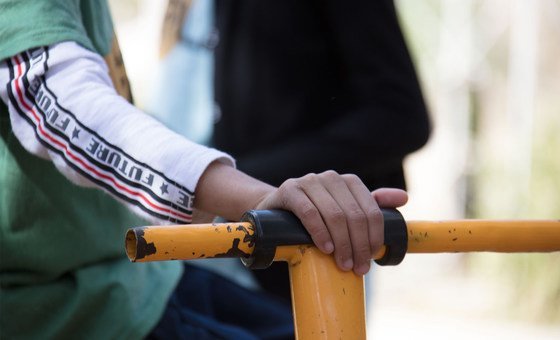Children comprise at least 30 per cent of migrants in Mexican shelters, who come from Honduras, Guatemala, El Salvador and the country itself. Half have travelled without their parents, which is among the highest proportions ever recorded in Mexico.
Jean Gough, UNICEF Regional Director for Latin America and the Caribbean, wrapped up a five-day visit to Mexico, which included stops along the northern border with the United States.
Overcrowded shelters
The agency estimates that an average of 275 additional migrant children find themselves in Mexico every day after being detected by the authorities, waiting to cross into the US, or being returned.
“I was heartbroken to see the suffering of so many young children, including babies, at the Mexican border with the US”, Ms Gough said.
“Most of the shelter facilities I visited in Mexico are already overcrowded and cannot accommodate the increasing number of children and families migrating northward. We are deeply concerned that living conditions for migrant children and mothers in Mexico could soon deteriorate further.”
Dangerous journeys, harrowing testimonies
Against the backdrop of the COVID-19 pandemic, the rise in unaccompanied migrant children, and the arrival of entire families with children, has put significant strain on Mexican assistance centres.
The journey from their homelands towards the US – often on the run from violence and destitution – is perilous, and can last up to two months, amid extremely harsh conditions.
UNICEF has collected harrowing testimonies of sexual abuse, extortion, kidnapping and human trafficking, among other violations. Some migrant women tearfully told UNICEF they were deprived of food, had their belongings confiscated, or slept on the floor, covering their children with their own bodies to keep them warm at night.
Abusive traffickers
“Central American families aren’t migrating — they are fleeing,” said Ms Gough. “These children and their parents who are now in Mexico escaped gang criminality, domestic violence, poverty, devastating hurricanes, and job loss due to the pandemic in their countries of origin. So why would they return? Often, there is nothing they could go back to.”
She added that traffickers are shamelessly taking advantage of their hopelessness and putting children’s lives at risk during this perilous journey.
“The best way to give migrant families a good reason to stay in their communities is to invest in their children’s future at the local level. The real child crisis is not at the US border; it’s in the poorest communities of northern Central America and Mexico.”
Invest in communities
Last year, UNICEF welcomed Mexico’s decision to reform its migration and refugee laws, which ban immigration detention for children and prioritize the best interests of migrant children in the development of immigration policies affecting them. It is critical that the international community support efforts towards the successful implementation of these reforms, the agency said.
UNICEF has also called on the international community to place children and women at the heart of all investment plans across Honduras, Guatemala, El Salvador and southern Mexico, in efforts to create better living conditions and opportunities for communities.
Last year, more than 7,160 “children on the move” benefited from UNICEF-supported assistance in Mexico, such as protection and psychological services, recreational and learning activities, and accommodation.
UNICEF and partners have been scaling up humanitarian response across Central America and Mexico in recent months, including stepping up presence at the Mexico-US border.
So far, over 2,100 migrant children have received assistance, and an additional 10,000 children and their parents will be reached this year.
However, with needs on the rise, and expected to remain high in the coming months, UNICEF is seeking $23 million to fund operations in Mexico to provide vulnerable groups with access to education, improved water and sanitation facilities, life skills and vocational training, alternative care, and violence protection activities.

